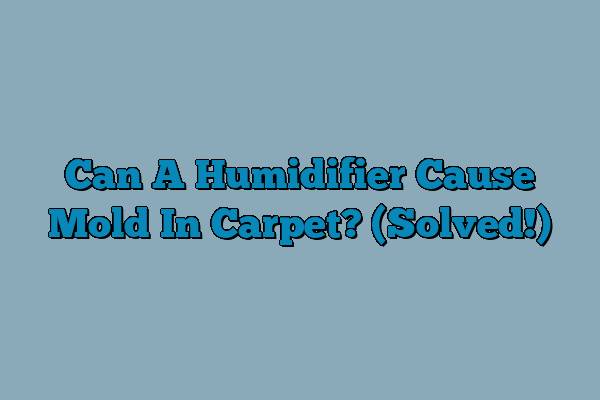Humidifiers are an important tool for maintaining optimum humidity levels in the home.
Yes, a humidifier can cause mold in carpet if it is not used properly. To prevent mold from forming, it is important to keep the relative humidity in your home at or below 50%, and to clean and empty your humidifier regularly.
When used correctly, they can help reduce dryness and improve air quality.
But when not properly monitored and maintained, a humidifier can cause mold growth on carpets and other surfaces.
This article will explore how to prevent this issue from occurring and discuss potential solutions if it does occur.
Humidity levels can have significant impacts on both living spaces as well as health.
For instance, high humidity has been linked to increased respiratory issues such as asthma attacks while low humidity is known to exacerbate skin irritation and allergies.
As such, using a humidifier helps maintain optimal humidity levels which reduces the risk of these conditions developing or worsening.
Unfortunately, too much moisture in the air can lead to condensation forming on walls, windowsills and furniture – leading to mold growth which may spread onto nearby carpets if not treated quickly enough.
In addition, a malfunctioning unit is also capable of producing excessive amounts of water vapor that can contribute towards fungal development within carpet fibers over time.
It is therefore essential to understand the risks associated with using a humidifier so that any problems caused by mold can be identified early and dealt with effectively before serious damage occurs.
Overview Of Carpet Mold
Carpet can be a sanctuary for mold growth, often hidden from view and wreaking havoc in the home. Prevention is key when it comes to carpet mold; understanding the symptoms, damage, and removal processes are vital to maintaining healthy carpets.
Carpet mold prevention begins with knowing what causes its development. Mold requires moisture and warmth to grow, therefore high indoor humidity levels create ideal conditions for rapid mold growth on surfaces like carpets.
Other elements such as poor ventilation or inadequate cleaning routines can also contribute to mold formation in carpets.

It is essential to recognize signs of mold early on before any permanent damage has been done.
Common carpet mold symptoms include visible discoloration or staining, musty odors that linger regardless of how much you clean, warping or softening of material fibers, and even allergies related to spores released into the air by active colonies.
To prevent further degradation caused by fungi, swift actions need to be taken once these indications appear: proper cleaning techniques should be employed along with adequate drying times followed up with professional steam-cleaning services if needed.
Understanding the relationship between humidity and carpet health will help us determine whether a humidifier poses a threat to our beloved floor coverings.
Humidity And Carpet Health
Humidity can have a direct impact on the health of carpet.
When humidity levels are too high, there is an increased chance of mold growth in carpets as spores thrive better in higher moisture environments.
Through proper prevention and maintenance techniques, it is possible to reduce the damage caused by excessive humidity levels.
For instance, making sure that carpets are vacuumed regularly helps rid them of dust mites and other particles that could attract moisture-loving organisms like mold or mildew. Additionally, using dehumidifiers when necessary can help keep indoor air at healthy levels for both humans and carpets alike.
Carpet owners should also ensure their rugs are aired out frequently and exposed to sunlight where possible; this will help dry up any dampness left behind from spills or condensation on walls or windowsills. By following these simple steps you can maintain optimal conditions for your carpet’s health and avoid costly repairs due to excess humidity.
The next section looks into the effects humidifiers can have on carpet mold growth and what preventive measures may be taken to mitigate its impacts.
Impact Of Humidifiers On Carpet Mold
Humidifiers have the potential to cause mold growth on carpets if not properly monitored. Carpet in a humid environment can easily become susceptible to mold due to its absorbent fibers, making it essential for homeowners to use precaution when using a humidifier.
Here are some tips that will help prevent carpet damage from humidifiers:
- Monitor the humidity levels regularly and adjust accordingly
- Ensure there is proper air circulation around furniture and carpets
- Clean the humidifier often
By following these simple steps, you can reduce your risk of having mold accumulate on your carpets.
It is important to remember though that even with all necessary precautions taken, an extreme amount of humidity could still lead to mold development.
Therefore, it’s best practice to keep an eye on any signs of moisture or discoloration in order to avoid long-term damage caused by mold infestations.
A dry and well ventilated home should be able to effectively mitigate most issues associated with excessive humidity.
With this knowledge, homeowners can safely enjoy all the benefits their humidifier brings without worrying about unnecessary damages occurring in their homes.
Strategies For Preventing Carpet Mold
Mold-proofing carpet is essential for protecting against the risk of growth caused by humidifiers. When it comes to humidity control, carpets are highly vulnerable to mold accumulation due to their absorbent nature and tendency to retain moisture.
Carpet cleaning techniques such as vacuuming and hot water extraction can help reduce the presence of dust and dirt which can lead to mold growth. Utilizing a dehumidifier in moist environments is also an effective method for reducing moisture levels in carpeted areas.
Carpet protection products such as sealants, stain guards, and anti-microbial sprays may be used on new or existing carpets to prevent contaminants from leading to mold formation.
Properly ventilated rooms should also be considered when attempting to maintain low levels of humidity indoors.
Regular inspection of carpets should be conducted in order to identify any signs of fungal development before they become too severe.
In situations where there has already been significant damage, professional removal services may need to be consulted for complete remediation of the affected area.
Conclusion
The conclusion of this article is that humidifiers can be a potential cause of mold in carpets.
High levels of humidity create an ideal environment for mold to grow and thrive, making it important for homeowners to take action against increased moisture levels in their home.
Careful monitoring, regular maintenance, and preventative measures should all be taken in order to protect the health and quality of carpets from damage caused by mold growth.
This knowledge is especially vital for households with children or pets who may spend long periods of time on carpeted floors. The risks associated with airborne spores produced by molds are real, so taking the necessary steps today can ensure healthier air tomorrow.
Homeowners must stay vigilant and proactive if they want to safeguard their family’s well-being as well as preserve the beauty and longevity of their carpets.
In summary, while humidifiers can certainly help bring comfort into homes during cold winter months, they also present a risk factor when it comes to mold growth on carpets – something that every homeowner needs to consider before introducing too much moisture into their living space. Taking precautionary measures such as regularly inspecting your home’s humidity levels and performing routine cleanings will go a long way towards protecting both you and your carpeting from the hazards posed by mold development.




